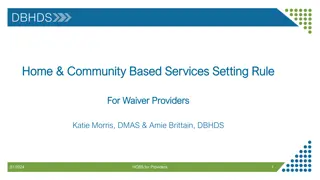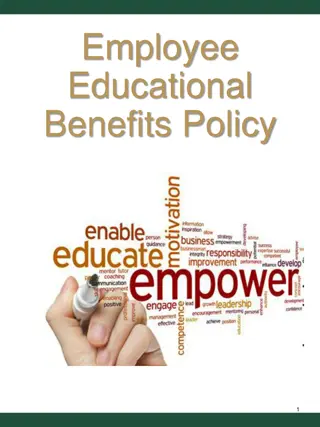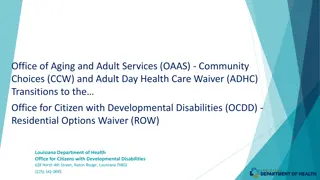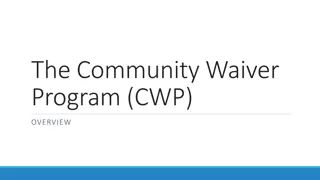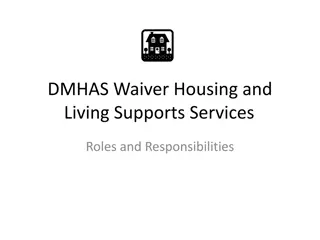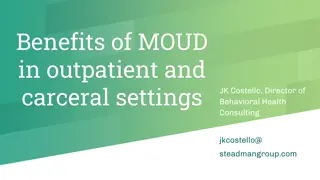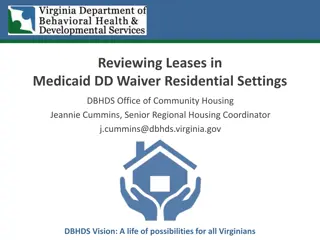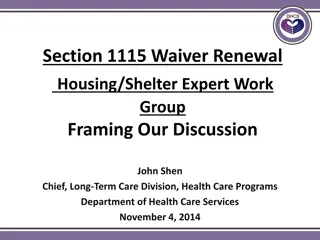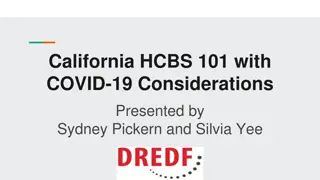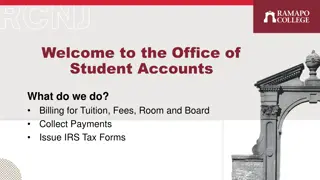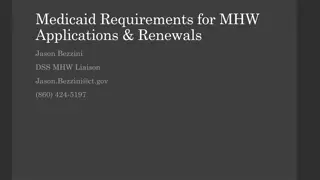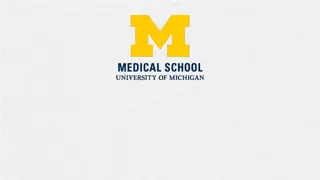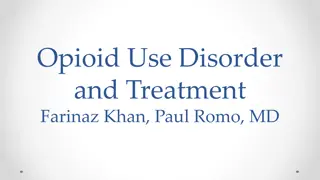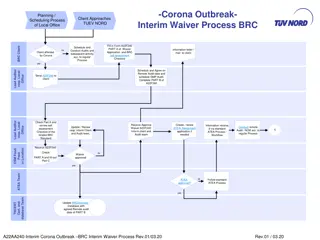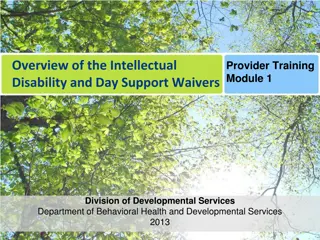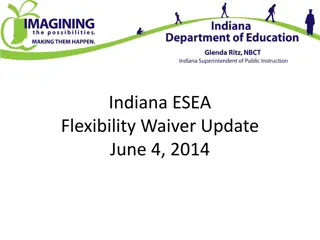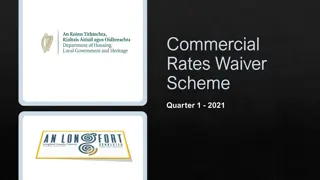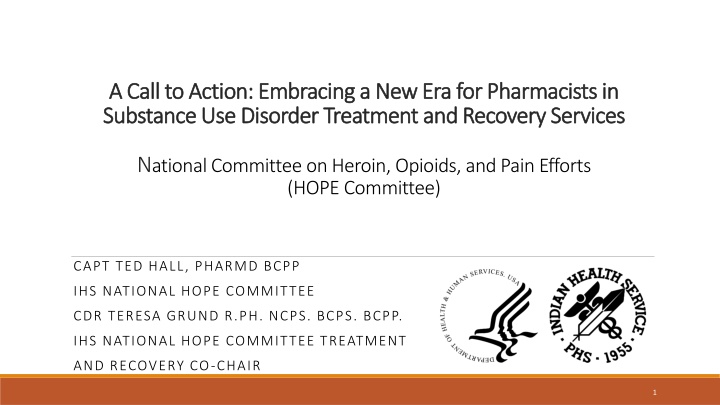
Embracing a New Era for Pharmacists in Substance Use Disorder Treatment
Explore the role of pharmacists in substance use disorder treatment and recovery services, including deploying naloxone, supporting work-life balance, and utilizing opioid stewardship tools. Learn about legislation shaping medication-assisted treatment evolution.
Download Presentation

Please find below an Image/Link to download the presentation.
The content on the website is provided AS IS for your information and personal use only. It may not be sold, licensed, or shared on other websites without obtaining consent from the author. If you encounter any issues during the download, it is possible that the publisher has removed the file from their server.
You are allowed to download the files provided on this website for personal or commercial use, subject to the condition that they are used lawfully. All files are the property of their respective owners.
The content on the website is provided AS IS for your information and personal use only. It may not be sold, licensed, or shared on other websites without obtaining consent from the author.
E N D
Presentation Transcript
A Call to Action: Embracing a New Era for Pharmacists in A Call to Action: Embracing a New Era for Pharmacists in Substance Use Disorder Treatment and Recovery Services Substance Use Disorder Treatment and Recovery Services National Committee on Heroin, Opioids, and Pain Efforts (HOPE Committee) CAPT TED HALL, PHARMD BCPP IHS NATIONAL HOPE COMMITTEE CDR TERESA GRUND R.PH. NCPS. BCPS. BCPP. IHS NATIONAL HOPE COMMITTEE TREATMENT AND RECOVERY CO-CHAIR 1
OBJECTIVES Identify resources to support new clinicians treating opioid use disorders Outline avenues for pharmacists to deploy naloxone as a harm reduction strategy Demonstrate the pharmacist s role in the treatment of opioid use disorders Propose clinician resiliency strategies to support work-life balance
SCOPE OF THE PROBLEM DATA Link to muggett presentation Michael Mudgett February 21,2023, Substance Use Data Among American Indian/Alaska Natives, Northwest Portland Area Indian Health Board https://www.indiancountryecho.org/resources/substance-use-data-among-american-indian-alaska-natives-february-21-2023/
PHARMACIST BASED NALOXONE DISPENSING HOPE Website Toolkit Standing Orders Available by OTC 2023 Co- Prescribing https://prescribetoprevent.org/wp2015/wp-content/uploads/naloxone-access.pdf
OPIOID STEWARDSHIP TOOLS AND RESOURCES IHS Opioid Surveillance Dashboard https://www.ihs.gov/opioids/opioidresponse/techassistance/ Opioid stewardship plan templates HOPE Website https://www.ihs.gov/sites/opioids/themes/responsive2017/display_objects/documents/opioidstewardshipwb.pdf
Evolution of MOUD Legislation 1970 - Controlled Substance Act | Controlled Substances Import and Export Act These laws are a consolidation of numerous laws regulating the manufacture and distribution of narcotics, stimulants, depressants, hallucinogens, anabolic steroids, and chemicals used in the illicit production of controlled substances. 1974 Narcotic Addict Treatment Act of 1974 - Public Law 93-281 Amends the Controlled Substance Act of 1970 to provide for the registration of practitioners conducting narcotic treatment programs. [methadone clinics] It also provides legal definitions for the phrases maintenance treatment and detoxification treatment . 2000 - The Drug Addiction Treatment Act of 2000 (DATA 2000) Amends the Controlled Substances Act to waive the requirement that practitioners who dispense narcotic drugs to individuals for maintenance or detoxification treatment annually obtain a separate registration for that purpose, It enables qualified physicians to prescribe and/or dispense narcotics for the purpose of treating opioid dependency 2005 - Public law 109-56 Amends the Controlled Substances Act to eliminate the 30-patient limit for medical group practices allowed to dispense narcotic drugs in schedules III, IV, or V for maintenance or detoxification treatment (retains the 30-patient limit for an individual physician). 2006 - Bill H.R.6344 This allows physicians who have been certified to prescribe certain drugs for the treatment of opioid dependence under DATA2000 to treat up to 100 patients (up from 30) by submitting an "intent" notification to the Dept of Health and Human Services. n 2016/2018 - Comprehensive Addiction and Recovery Act of 2016 (CARA) and Substance Use Disorder Prevention thath Promotes Recovery and Treatment of Patients and Communities Act of 2018 (SUPPORT) SUPPORT ACT: Amends the Controlled Substance Act - to allow Nurse Practitioners and Physician Assistants to become eligible to prescribe buprenorphine for the treatment of opioid use disorder. See the entire laws for more details 2023 - Consolidated Appropriations Act of 2023 Amends the Control-led Substance Act of 1970 to eliminate the DATA-Waiver requirement The Mainstreaming Addiction Treatment (MAT) Act (H.R. 1384 / S. 445) eliminates the need for a separate waiver to dispense buprenorphine, a medication to treat OUD The Medication Access and Training Expansion (MATE) Act (H.R. 2067 / S. 2235) requires all prescribers of federally controlled substances to complete 8 hours of training on treating and managing patients with opioid use disorder (OUD) and substance use disorder (SUD) The Collaborate in an Orderly and Cohesive Manner Act (H.R. 5218) provides grants and technical assistance for using the Collaborative Care Model to integrate behavioral health into primary care
PHARMACISTS ROLES IN MOUD The ASAM National Practice Guideline for the Treatment of Opioid Use Disorder: 2020 Focused Update Completion of all assessments should not delay or preclude initiating pharmacotherapy for opioid use disorder A patient s decision to decline psychosocial treatment or the absence of available psychosocial treatment should not preclude or delay pharmacotherapy Direct services CPA/DEA Buprenorphine Antagonists-naltrexone Resources HOPE Website Inductions support- WARMLINE Advancing Pharmacist Roles in Substance Use Disorder Treatment and Recovery ECHO Co-management Assessment Induction Follow up care Dose adjustments Documentation http://eguideline.guidelinecentral.com/i/1224390-national-practice-guideline-for-the-treatment-of-opioid-use-disorder-2020- update/5?
Medications for Opioid Use in the Primary Care Setting Controlled substances under schedules III, IV, and V, approved to treat opioid use disorders can now be provided by primary care and general health care providers with a DEA number. The changes to the controlled substance act to not pertain to methadone as it is a schedule II- controlled substance. Naltrexone is not a controlled substance and remains appropriate for use in primary care settings Harm Reduction Model No requirement for psychosocial and behavioral health services Psychosocial and behavioral service should be made available via referral
IHS NATIONAL FORMULARY FOLLOW LOCAL POLICIES AND PROCEDURE RELATED TO DISPENSING CONTROLLED SUBSTANCES.
Provider Resiliency Aim: In this qualitative study, we aimed to identify factors associated with burnout and, conversely, resilience among multidisciplinary providers working on Addiction Consultation Services (ACS). Methods: We completed 26 semi-structured interviews with clinicians working on ACS, including physicians, social workers, and advanced practice providers. Results: Providers described factors contributing to burnout and strategies for promoting resilience, and three main themes arose: (1) Systemic barriers contributed to provider burnout, (2) Engaging in meaningful work increased resilience, and (3) Team dynamics influenced perceptions of burnout and resilience. Conclusion: Our results suggest that hospital-based addiction medicine work is intrinsically rewarding for many providers and that engaging with other addiction providers to debrief challenging encounters or engage in advocacy work can be protective against burnout. However, administrative and systemic factors are frequent sources of frustration for providers of ACS. Structured debriefings may help to mitigate burnout. Furthermore, training to enhance providers' ability to engage effectively in advocacy work within and between hospital systems has the potential to promote resilience and protect against burnout among ACS providers. Bredenberg, Erin, et. al. Identifying factors that contribute to burnout and resiliency among hospital-based addiction medicine providers: A qualitative study . Journal of Substance Abuse Treatment. Vol. 144, 108924 (January 2023) Accessed 03/15/2023 at https://www.jsatjournal.com/article/S0740-5472(22)00206-9/fulltext
Provider Resiliency Six Themes: 1. Tenacity Aspiration and Commitment 2. Resources Support, Teamwork, and Institutional Culture 3. Control Professional Boundaries, Acknowledging One s Own Limitations, and Work-Life Balance 4. Adaptive Coping 5. Reflective Ability 6. Growth Roslan, N.S.; Yusoff, M.S.B.; Morgan, K.; Ab Razak, A.; Ahmad Shauki, N.I. What Are the Common Themes of Physician Resilience? A Meta-Synthesis of Qualitative Studies. Int. J. Environ. Res. Public Health 2022,19, 469. https://doi.org/10.3390/ijerph19010469
CLINICIAN CLINICIAN- -TO TO- -CLINICIAN CLINICIAN SUBSTANCE USE WARMLINE (855) 300 (855) 300- -3595 6am - 5pm PST (Mon-Fri) or submit cases online at nccc.ucsf.edu 3595 Free, confidential, on-demand tele-consultation service for IHS/Tribal/Urban Indian clinicians seeking expert recommendations on evaluation and management of opioid, alcohol, and other substance use. We welcome calls from all healthcare providers in IHS, tribal, and urban facilities. We can help: Assess cases Build your capacity Communication Strategies to improve rapport with patients. no matter how straightforward or complex and help guide treatment planning. to assist people with, or vulnerable to, use disorders and develop safer medication strategies. Our knowledgeable, compassionate physicians, clinical pharmacists, and advanced practice nurses are available to providers of all experience levels. This National Clinician Consultation Center program is supported by the Health Resources and Services Administration (HRSA) of the U.S. Department of Health and Human Services (HHS) as part of an award totaling $2,633,756 with 0% financed with non-governmental sources.
Resources Michael Mudgett February 21,2023, Substance Use Data Among American Indian/Alaska Natives, Northwest Portland Area Indian Health Board https://www.indiancountryecho.org/resources/substance-use-data-among-american-indian-alaska-natives-february-21-2023/ https://prescribetoprevent.org/wp2015/wp-content/uploads/naloxone-access.pdf https://www.ihs.gov/opioids/opioidresponse/techassistance/ https://www.ihs.gov/sites/opioids/themes/responsive2017/display_objects/documents/opioidstewardshipwb.pdf http://eguideline.guidelinecentral.com/i/1224390-national-practice-guideline-for-the-treatment-of-opioid-use-disorder- 2020-update/5?


